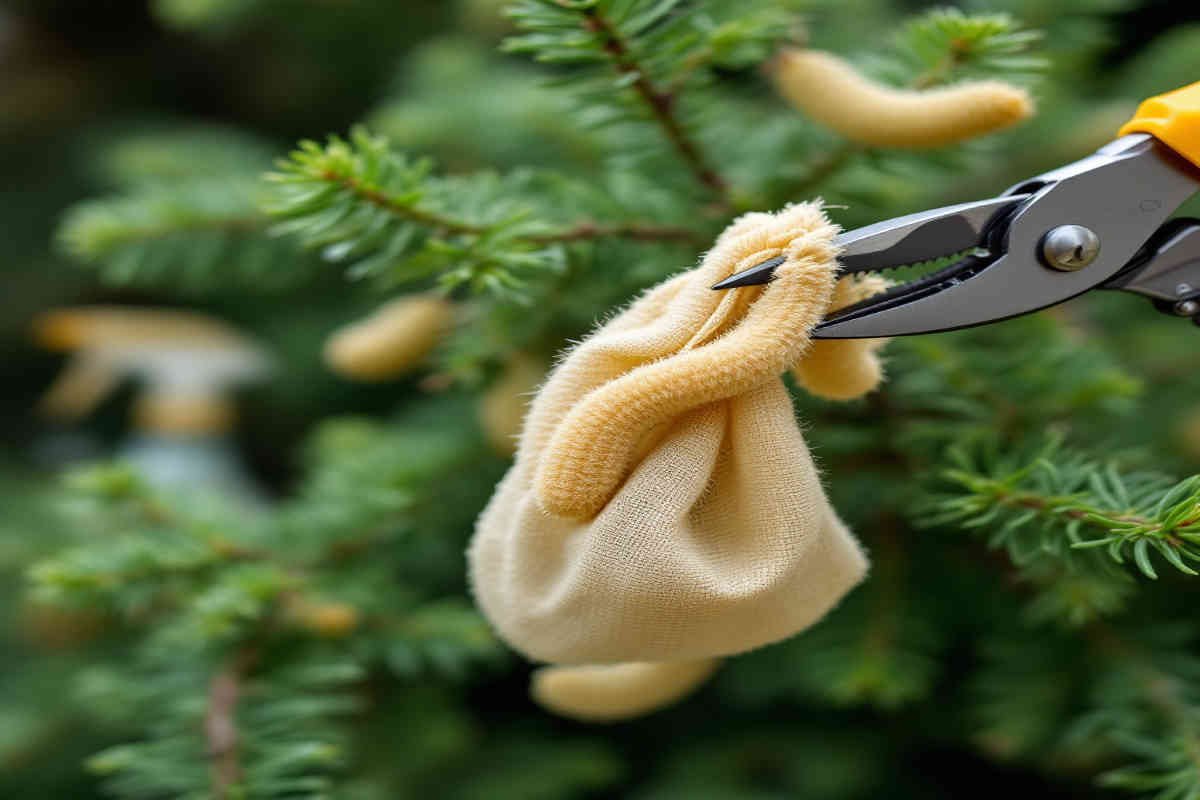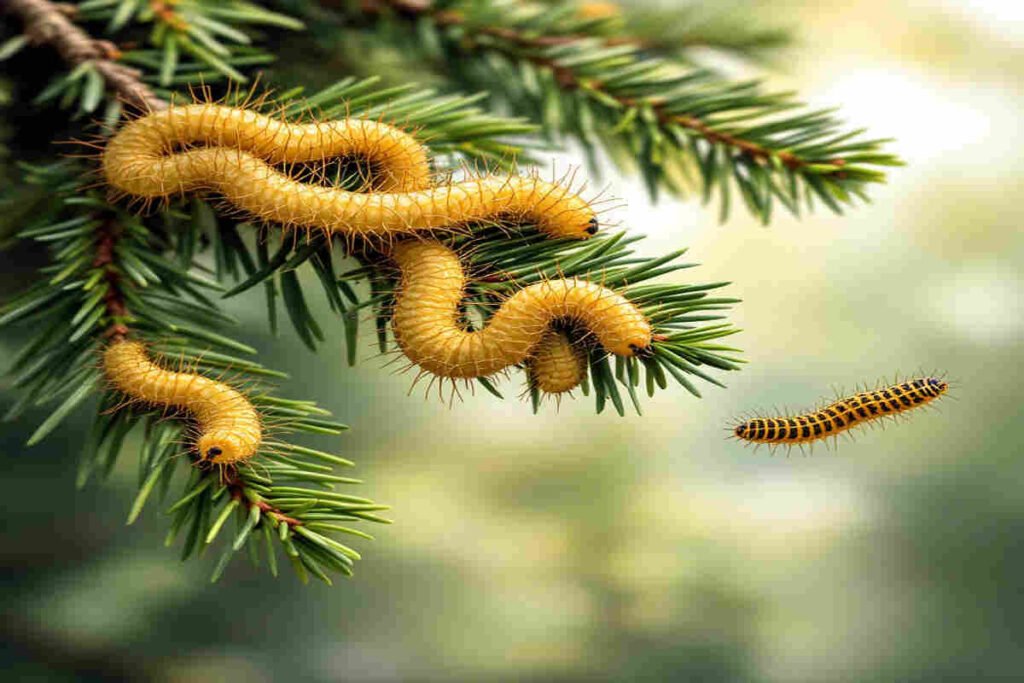Bagworms are one of the most stubborn and destructive pests that can wreak havoc on your garden or landscape. You’re not alone if you’ve noticed those unsightly bags hanging from your plants or seen the damage they cause. Finding an effective solution is crucial for homeowners with an eye on maintaining a healthy and beautiful outdoor space
Understanding Bagworms: Biology and Damage
What Are Bagworms?
Bagworms are the larvae of a moth species (Thyridopteryx ephemeraeformis) notorious for their destructive feeding habits. These pests get their name from the distinct “bags” they create, which are made of silk and pieces of the host plant. These bags serve as both camouflage and protection for the larvae.
The larvae emerge in the spring and begin feeding on the foliage of trees and shrubs, with a preference for evergreens like junipers, cedars, and arborvitae. However, they can also attack broadleaf plants, leaving behind brown, defoliated branches and damaged leaves.
Life Cycle and Behavior
Bagworms have a one-generation-per-year life cycle. Understanding their stages can help you target them effectively:
- Egg Stage: Overwintering occurs in the bags of the previous year’s females.
- Larvae Stage: Eggs hatch in late spring or early summer, and the larvae immediately begin feeding. This stage is when they are most vulnerable.
- Pupation and Adult Stage: By late summer, the larvae mature, pupate, and emerge as adult moths. Females remain in their bags, while males fly to mate.
- Egg Laying: Females lay eggs inside their bags before dying, setting the stage for the next generation.
Damage Caused by Bagworms
Bagworm infestations can result in:
- Defoliation: They strip plants of their foliage, which can weaken or kill the host plant.
- Stress on Plants: Evergreens are particularly vulnerable because they do not regrow needles.
- Aesthetic Damage: The bags are unsightly and can ruin the appearance of ornamental plants.
Signs of Infestation
To identify bagworm problems early:
- Look for small, cone-shaped bags hanging from branches.
- Check for defoliation or browning of leaves/needles.
- Monitor for larvae actively feeding during late spring and early summer.
Conventional Bagworm Control Methods
Mechanical/Physical Control
One of the easiest and most effective ways to control bagworms is manually removing their bags from plants.
See also kill carpenter bees
- When to Do It: This method works best in fall, winter, or early spring when the bags contain eggs.
- How to Do It: Pluck the bags from the branches and destroy them by burning or sealing them in a plastic bag.
- Pros and Cons: This method is environmentally friendly but can be time-consuming, especially for large infestations.
Chemical Control
Chemical treatments are often necessary for severe infestations. The key to success lies in timing:
- Best Time for Application: Apply insecticides in late spring or early summer when larvae feed small and actively.
- Recommended Insecticides: Products containing bifenthrin, carbaryl, spinosad, or Bacillus thuringiensis (Bt) are commonly used.
- Limitations: These treatments are less effective on larvae entering their bags or in the pupation stage.
Safety and Environmental Considerations
When using chemical controls:
- Follow label instructions to minimize risks to beneficial insects like pollinators.
- Avoid applying insecticides during windy or rainy conditions to prevent drift and runoff.
What Is Ortho Home Defense?
Ortho Home Defense is a popular insect control product for indoor and outdoor use. Its versatility and effectiveness make it a go-to solution for homeowners dealing with various pests, including bagworms.
Key Features of Ortho Home Defense
- Broad-Spectrum Control: Kills insects such as ants, roaches, spiders, and bagworms.
- Application Methods: Can be used indoors on nonporous surfaces and outdoors as a perimeter barrier.
- User-Friendly Design: Comes with a Comfort Wand for precise application and a quick-drying formula.
- Safety: People and pets can re-enter treated areas once the product has dried.
How It Fits into Pest Management
Ortho Home Defense is an excellent addition to your pest control routine. It works as a preventative measure and a treatment for active infestations, ensuring your home and garden remain pest-free.
Does Ortho Home Defense Kill Bagworms?
The Short Answer
Yes, Ortho Home Defense can kill bagworms when used correctly. Its active ingredients, such as bifenthrin, are highly effective against bagworm larvae.
See also solution for springtail infestations
How It Works
- Contact Kill: The product kills bagworms on contact, stopping them from feeding and causing further damage.
- Residual Effect: It leaves a protective barrier that kills bagworms for weeks after application.
Timing Matters
The effectiveness of Ortho Home Defense depends on when you apply it. For the best results:
- Treat in spring to early summer, when the larvae are small and actively feeding.
- Avoid treating during the pupation stage, as the product will not penetrate closed bags.
Comparison With Other Insecticides
Products like spinosad and Bacillus thuringiensis (Bt) are also effective. However, Ortho Home Defense provides a broader range of insect control, making it a versatile option for homeowners.
Tips for Application
- Focus on infested plants and their surroundings.
- Combine chemical treatment with physical removal for the best results.
- Monitor treated areas for signs of recurring infestations.
Limitations
Ortho Home Defense may not be effective on larvae hidden inside their protective bags. This is why combining treatments is essential for complete control.
How to Use Ortho Home Defense for Bagworm Control
Step-by-Step Guide
- Prepare the Area: Clear debris around plants and prune heavily infested branches.
- Choose the Right Time: Apply in late spring or early summer.
- Apply the Product:
- Shake the container well before use.
- Use the Comfort Wand for even application.
- Focus on infested branches and surrounding areas.
- Safety Precautions: Wear gloves and protective clothing. Keep pets and children away from the treated area until it dries.
- Monitor Results: Check for reduced bagworm activity in 1-2 weeks. Repeat treatment if necessary.
Frequency of Treatment
- Reapply every few weeks during the active feeding period.
- Combine with manual removal for long-term success.
See also impact on ladybugs explained

